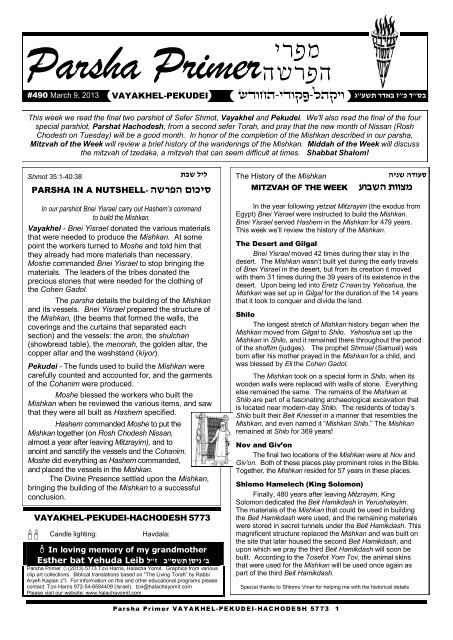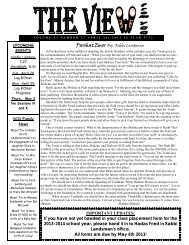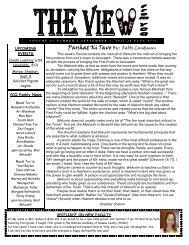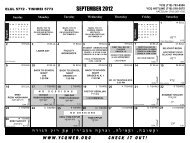You also want an ePaper? Increase the reach of your titles
YUMPU automatically turns print PDFs into web optimized ePapers that Google loves.
Parsha Primer<br />
שדוח<br />
#490 March 9, 2013 VAYAKHEL-PEKUDEI<br />
ג"עש ת רדאב<br />
ז"כ ד"סב<br />
PARSHA IN A NUTSHELL- השרפה םוכיס<br />
In our parshiot Bnei Yisrael carry out Hashem’s command<br />
to build the Mishkan.<br />
Vayakhel - Bnei Yisrael donated the various materials<br />
that were needed to produce the Mishkan. At some<br />
point the workers turned to Moshe and told him that<br />
they already had more materials than necessary.<br />
Moshe commanded Bnei Yisrael to stop bringing the<br />
materials. The leaders <strong>of</strong> the tribes donated the<br />
precious stones that were needed for the clothing <strong>of</strong><br />
the Cohen Gadol.<br />
The parsha details the building <strong>of</strong> the Mishkan<br />
and its vessels. Bnei Yisrael prepared the structure <strong>of</strong><br />
the Mishkan, (the beams that formed the walls, the<br />
coverings and the curtains that separated each<br />
section) and the vessels: the aron, the shulchan<br />
(showbread table), the menorah, the golden altar, the<br />
copper altar and the washstand (kiyor).<br />
Pekudei - The funds used to build the Mishkan were<br />
carefully counted and accounted for, and the garments<br />
<strong>of</strong> the Cohanim were produced.<br />
Moshe blessed the workers who built the<br />
Mishkan when he reviewed the various items, and saw<br />
that they were all built as Hashem specified.<br />
Hashem commanded Moshe to put the<br />
Mishkan together (on Rosh Chodesh Nissan,<br />
almost a year after leaving Mitzrayim), and to<br />
anoint and sanctify the vessels and the Cohanim.<br />
Moshe did everything as Hashem commanded,<br />
and placed the vessels in the Mishkan.<br />
The Divine Presence settled upon the Mishkan,<br />
bringing the building <strong>of</strong> the Mishkan to a successful<br />
conclusion.<br />
<br />
VAYAKHEL-PEKUDEI-HACHODESH 5773<br />
Candle lighting: Havdala:<br />
In loving memory <strong>of</strong> my grandmother<br />
Esther bat Yehuda Leib ל " ז ב"סשת ןסינ 'ב<br />
Parsha Primer (2013) 5773 Tzvi Harris, Halacha Yomit. Graphics from various<br />
clip art collections. Biblical translations based on “The Living Torah” by Rabbi<br />
Aryeh Kaplan z”l. For information on this and other educational programs please<br />
contact: Tzvi Harris 972-54-6584409 (Israel). tzvi@halachayomit.com<br />
Please visit our website: www.halachayomit.com<br />
ירפמ<br />
השרפה<br />
This week we read the final two parshiot <strong>of</strong> Sefer Shmot, Vayakhel and Pekudei. We'll also read the final <strong>of</strong> the four<br />
special parshiot, Parshat Hachodesh, from a second sefer Torah, and pray that the new month <strong>of</strong> Nissan (Rosh<br />
Chodesh on Tuesday) will be a good month. In honor <strong>of</strong> the completion <strong>of</strong> the Mishkan described in our parsha,<br />
Mitzvah <strong>of</strong> the Week will review a brief history <strong>of</strong> the wanderings <strong>of</strong> the Mishkan. Middah <strong>of</strong> the Week will discuss<br />
the mitzvah <strong>of</strong> tzedaka, a mitzvah that can seem difficult at times. Shabbat Shalom!<br />
Shmot 35:1-40:38<br />
תבש ליל<br />
ה-ידוקפ-להקיו<br />
The History <strong>of</strong> the Mishkan<br />
P ars ha Pr im er VAYA K HE L-PE K UD E I - HA C H OD E S H 57 73 1<br />
הינש הדועס<br />
MITZVAH OF THE WEEK עובשה תווצמ<br />
In the year following yetziat Mitzrayim (the exodus from<br />
Egypt) Bnei Yisrael were instructed to build the Mishkan.<br />
Bnei Yisrael served Hashem in the Mishkan for 479 years.<br />
This week we’ll review the history <strong>of</strong> the Mishkan.<br />
The Desert and Gilgal<br />
Bnei Yisrael moved 42 times during their stay in the<br />
desert. The Mishkan wasn’t built yet during the early travels<br />
<strong>of</strong> Bnei Yisrael in the desert, but from its creation it moved<br />
with them 31 times during the 39 years <strong>of</strong> its existence in the<br />
desert. Upon being led into Eretz C’naan by Yehoshua, the<br />
Mishkan was set up in Gilgal for the duration <strong>of</strong> the 14 years<br />
that it took to conquer and divide the land.<br />
Shilo<br />
The longest stretch <strong>of</strong> Mishkan history began when the<br />
Mishkan moved from Gilgal to Shilo. Yehoshua set up the<br />
Mishkan in Shilo, and it remained there throughout the period<br />
<strong>of</strong> the sh<strong>of</strong>tim (judges). The prophet Shmuel (Samuel) was<br />
born after his mother prayed in the Mishkan for a child, and<br />
was blessed by Eli the Cohen Gadol.<br />
The Mishkan took on a special form in Shilo, when its<br />
wooden walls were replaced with walls <strong>of</strong> stone. Everything<br />
else remained the same. The remains <strong>of</strong> the Mishkan at<br />
Shilo are part <strong>of</strong> a fascinating archaeological excavation that<br />
is located near modern-day Shilo. The residents <strong>of</strong> today’s<br />
Shilo built their Beit Knesset in a manner that resembles the<br />
Mishkan, and even named it “Mishkan Shilo.” The Mishkan<br />
remained at Shilo for 369 years!<br />
Nov and Giv’on<br />
The final two locations <strong>of</strong> the Mishkan were at Nov and<br />
Giv’on. Both <strong>of</strong> these places play prominent roles in the Bible.<br />
Together, the Mishkan resided for 57 years in these places.<br />
Shlomo Hamelech (King Solomon)<br />
Finally, 480 years after leaving Mitzrayim, King<br />
Solomon dedicated the Beit Hamikdash in Yerushalayim.<br />
The materials <strong>of</strong> the Mishkan that could be used in building<br />
the Beit Hamikdash were used, and the remaining materials<br />
were stored in secret tunnels under the Beit Hamikdash. This<br />
magnificent structure replaced the Mishkan and was built on<br />
the site that later housed the second Beit Hamikdash, and<br />
upon which we pray the third Beit Hamikdash will soon be<br />
built. According to the Tosefot Yom Tov, the animal skins<br />
that were used for the Mishkan will be used once again as<br />
part <strong>of</strong> the third Beit Hamikdash.<br />
Special thanks to Shlomo Viner for helping me with the historical details






